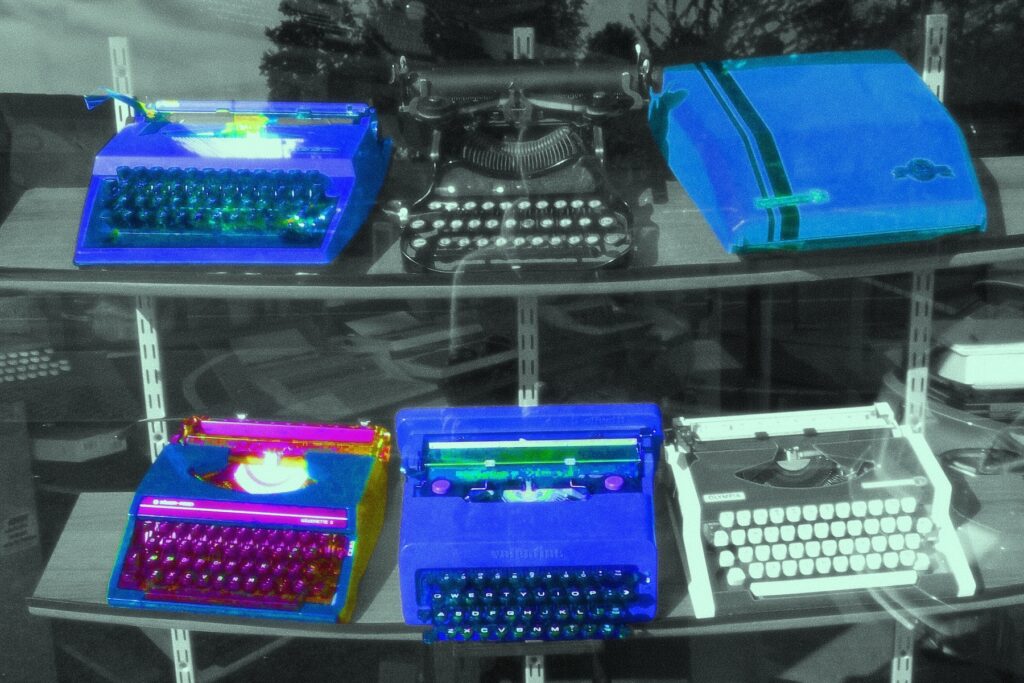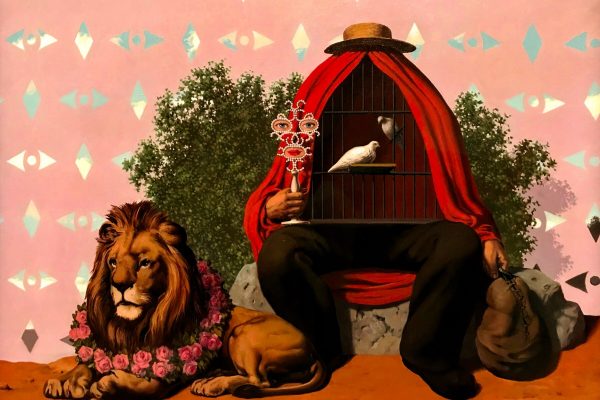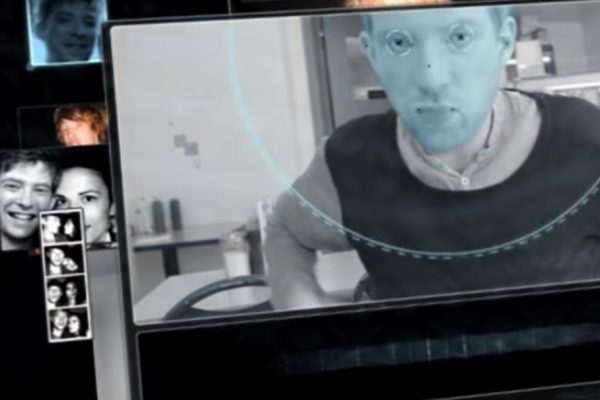Do You Remember Being Born?
Sean Michaels
Astra House, $27 (cloth)
Death of an Author
Stephen Marche
Pushkin Industries, $3.99 (eBook)
Air Age Blueprint
K Allado-McDowell
Ignota Books, £13.99 (paper)
The Italian novelist Italo Calvino was unusually optimistic about the invention of a “literature machine.” In his 1967 essay “Cybernetics and Ghosts,” he imagines a computer that would be “capable of conceiving and composing poems and novels,” bringing to the page what humans “are accustomed to consider as the most jealously guarded attributes in our psychological life.” For him, literature is simply “a combinatorial game that pursues the possibilities implicit in its own material, independent of the personality” of the writer. When read today, Calvino’s predictions—“provocative and even profane” at the time, as he admitted—seem eerily prescient.
Calvino equated the mind to a machine. Writers, he believed, “are already writing machines, or at least they are when things are going well.” This computationalist theory of the mind has since grown in popularity, endorsed by cognitive science researchers, philosophers, and, most recently and perhaps most zealously, by proponents of artificial intelligence. Some in this latter camp have embraced computationalism to extreme ends, supposing that the widespread use of generative AI models will “democratize” art and art-making, rendering the manual production of art irrelevant and unnecessary. Why paint a landscape when you can prompt a computer to do it for you?
It’s impossible to know whether Calvino would have embraced generative AI. But had he been alive to witness the advent of large language models like ChatGPT, I suspect he would have gladly bid good riddance to the author, “that anachronistic personage . . . that spoiled child of ignorance.” Instead, he would elevate the reader. “Once we have dismantled and reassembled the process of literary composition,” he wrote, “the decisive moment of literary life will be that of reading.” Literature, henceforth, would attain its cultural relevance through the human reader, whose gaze transfigures the written word into a social dialogue. No matter whether the author is human or machine, “the work will continue to be born.” The reader must always be human; the author, not quite.
These days, it is something of a fool’s errand to try to determine whether a text encountered online is written by a human or a chatbot. You might think a text sounds cheesy, canned, or off-the-shelf, but isn’t a lot of human writing just that? There’s little evidence within text itself, unlike images produced by DALL-E, Stable Diffusion, or Midjourney, that can clue readers into its machine-generated nature. In moments of doubt, I think of Gertrude Stein’s infamous line, “A rose is a rose is a rose.” Isn’t a word a word—still a word—regardless of who, or what, wrote it? And if so, what does the rise of generative AI mean for literature? Should authors of poems and novels view chatbots as creative collaborators or as formal containers, delimiting what’s written on the page? And how do we evaluate if a machine’s work is worth reading?
These questions have plagued me since ChatGPT was released last fall, and they’ve reemerged with the recent publication of three novels that contain machine-generated text: Sean Michaels’s Do You Remember Being Born?, Stephen Marche’s Death of an Author (published under the pseudonym Aidan Marchine), and K Allado-McDowell’s Air Age Blueprint.
The large language models (LLMs) behind today’s chatbots are powered by deep learning algorithms that are trained on massive quantities of text to process, predict, and craft responses to written user queries. Despite simulating a humanlike autonomy, they run on a great deal of hidden human labor. Indeed, LLMs are designed to improve their output over time, based on input and critical feedback from human users. ChatGPT, for instance, can generate fiction, recipes, poems, code, adverts, academic essays, social media copy—virtually any kind of text imaginable, in any style you please. Without careful prompting, however, the quality of the typical prose output is often mediocre and monotone. In its usual voice, the bot writes with the expository flair of a high schooler’s research paper, an unsurprising result given what ChatGPT is trained on: a wide and inconsistent range of prose data from various online sources, from Reddit forums and fanfiction sites to nineteenth-century romance novels.
Still, writers have found the creative potential of these word-machines disquieting. Dismissive hostility is the dominant mood in the face of the looming threat of creative displacement. Critiques of LLMs have ranged from level-headed skepticism to overt antagonism; machine-generated works, by and large, are discounted as experiments and not “real” literature. And given how most models have been trained on human-produced writing found online, often without permission, some argue that using ChatGPT isn’t writing so much as plagiarism.
Here I will set aside the (important) question of the ethics of the private construction and distribution of these tools. Initially, my interest in these novels stemmed from their experimental verve and the question of whether AI can write “well.” Of course, in a literary environment where blurbs and publisher-manufactured hype determine a novel’s fate, the mere use of AI can serve as an easy marketing gimmick; curiosity as to quality is good for sales and clicks. In most of the reviews of AI-affiliated novels published so far, the human critic resembles a hound dog, trailing the scent of a clunky phrase or a digressive paragraph, sniffing for something that reaffirms our superiority in the realm of language. Might we ask something else? I think we can. As a first step, we shouldn’t lump machine-generated works under the vague umbrella of “AI writing” or, worse, “AI novel”—categories that cede credit to the computer and neglect the human author’s role in prompting, organizing, revising, and writing the work. “Programmatic” or “computational” literature might be more apt terms.
Aside from AI’s presence and assistance in generating the text, these three novels vary in style and structure. Death of an Author is a crime novella written in close third person. Professor Gus Dupin is suspected of murdering famous Canadian author and computing pioneer Peggy Firmin, who is killed while working on a project with a tool called Marlow AI. Do You Remember Being Born? follows Pulitzer Prize–winning poet Marian Ffarmer, who is asked to collaborate with Charlotte, an AI poetry bot, in exchange for a hefty check. Written mostly from Marian’s perspective, the novel unfolds over the course of the week that she spends in Silicon Valley. There are occasional second-person interludes chronicling Marian’s personal life, providing insight into her personality. Air Age Blueprint is a collage-like novel composed of first-person journal entries and “lost” manifestos penned by its unnamed protagonist, a failed filmmaker and poet. While embarking on a road trip to the West, they are recruited by an agent to work on an AI program and network called Shaman.AI.
All these novels share an aptly metafictional slant—reflecting, perhaps, our neuroses about Big Tech’s encroaching dystopia and the fate of textual meaning in the age of humanlike text generation. The protagonists are themselves entangled with powerful tech corporations devising AI that may or may not have dire consequences for humanity’s future. They recall the postmodern plots of novels from the 1980s, in which narrators comment anxiously and endlessly on the laborious process of writing, and where writing about writing functions as a sort of self-parodic cliché. “Another story about writing a story! Another regressus in infinitum!” exclaims John Barth’s narrator in his short story “Life-Story.” “Who doesn’t prefer art that at least overtly imitates something other than its own processes?” wonders the text about its own process.
These new novels lose some of the tortured irony about the task of writing while retaining its recursive effect: writing with and about AI is new enough to be controversial that it doesn’t need to be so ironic, hence the impulse to justify this creative choice within the text itself. Air Age Blueprint features a techno-optimist agent named K, assumed to be Allado-McDowell’s fictional stand-in, who boldly proclaims: “AI will open new worlds to us. It will let in new futures and timelines that we haven’t imagined before. It all depends on how we design it and what we decide to use it for.” The avatar of Peggy Firmin, the murdered writer in Death of an Author, tells Gus: “To become an author is to make a declaration: ‘I want to live beyond my body,’” explaining (spoiler alert) that she “had to give up [her] body to live past” it. Peggy, in her death, lives on as a language model in technological posterity: “If I hadn’t died, I would have written that somewhere.”
And in Do You Remember Being Born? an aging poet decides to “sell out” to a tech company in the sunset of her career, after decades of making very little money. A compassionate and lyrical portrait of an artist whose craft is “threatened” by emerging technology, the novel is an artfully constructed story about the sacrifices of making art, artistic collaboration, and the nature of motherhood. Ffarmer, modeled after the modernist poet Marianne Moore, has spent most of her life writing poems in solitude while living at her mother’s beck and call. She herself, however, was largely an absent mother to her only son. An opportunity from the Tech Company to write a collaborative poem with AI could define Marian’s career, but it could also allow her, for once, to support her son by helping him purchase a house. When Marian is asked on a talk show whether poets are “the next truck drivers” at risk of being replaced, she retorts with septuagenarian spunk: “Computers can mimic. They can’t invent.” Of writing poetry with a computer, Marian thinks: “There is actually something worse than an empty page . . . a page that fills up, of its own accord, with emptiness.” Such meta-commentary imbues all these novels with a dose of realism. The technological exposition hinges the narrative to a specific moment in time—our time, when LLMs are an unfamiliar, yet encroaching technology.
This may be the defining characteristic of recent machine-generated novels. Its protagonists are grappling with the controversial presence of AI, while the plot loosely addresses AI’s generative, if limited, capabilities. By this I mean: language models have a “generative” effect upon the novels’ content in imitating text input provided by human writers, but whatever form this mimetic (and predictive) output takes is left up to a human editor.
Imitation occurs on multiple levels with the human writer still on the authorial pedestal. LLMs produce mimetic texts that are then taken apart piecemeal, revised, and stitched into dialogue, poetic stanzas (Do You Remember Being Born?), or dense cybernetic manifestos (Air Age Blueprint). There is also the matter of the human author’s imitative instincts, reflected in the novel’s overarching style or genre. Of the three, Death of an Author is perhaps the most radical in approach: 95 percent of the text was generated with the help of three different chatbots (ChatGPT, Sudowrite, and Cohere), but the novella is quite conventional in prose and pacing. The detached, fast-paced narration recalls the works of crime novelists like Agatha Christie and Raymond Chandler, who Marche studied up on while preparing to produce the text. Marche functioned more like a product manager or a story editor than an author. He saw his tasks as prompting the chatbots, charting the plot, and compiling the generated text into a coherent and compelling narrative. Marche’s patchwork effort recalls what the critic Elizabeth Hardwick wrote of the novelist’s task: “Where to start and how to end, how much must be believed and how much a joke, a puzzle; how to combine the episodic and the carefully designed and consequential.”
Gus, a crime and cyber fiction scholar, is invited to Firmin’s funeral, where he is identified as a murder suspect. He begins investigating the circumstances of her death and is mailed one of her short stories, “a literary puzzle” that fictionalizes her own death and funeral. Gus sets out to understand what transpired between Firmin and Neil Gibson, cofounder of Marlow AI. The story is fine, if formulaic; what is groundbreaking is Marche’s process—how he prompted the novella into existence by essentially reverse-engineering tone and style, with the right amount of description: “The odorless precision of the hologram smoke left Gus longing for the smell, like an itch on a phantom limb.” Also crucial, apparently, was Marche’s literary knowledge and academic background. “If I were making a prediction, it would be that the people who are going to make the best AI literary art will require, at a minimum, the level of familiarity with literature that a Comp Lit PhD acquires for the general field examination,” Marche wrote in the novella’s afterword. Such literary discernment would allow the human editor to weed out AI-generated clichés, determine a consistent style, and structure the story with some momentum.
As a crime novella, Death of an Author appeared to be the best formal use case for AI. LLMs are more inclined toward traditional or formulaic works, like poems with closed metrical forms. Yet Marche confessed that it was difficult to prompt the bots into constructing an original plot. If the production of disorder, as Calvino believed, is a uniquely human urge, then the meandering temperament of plot (“where to start and where to end”) may be a manifestation of that impulse—something too disorderly for the machine to grasp.
If asked to make a judgment, I would say that Do You Remember Being Born? far outshines its peers. Perhaps my judgment is clouded by Michaels’s conservative and discerning use of AI more as a supplement than substitute for writing, but the prose is exceptional. Every chapter contains a careful selection of machine-generated words, clauses, or sentences that seamlessly blend with Michaels’s lyrical style. I was impressed by the contextual ingenuity of certain phrases and the surprising imagery invoked by the machine, when writing as Marian. “I had mistaken a fit of algorithmic exuberance for the truth.” In another eerily perceptive instance, “We would not be written out quite yet.” Toward the novel’s end are two or so pages seemingly written from the perspective of Charlotte, the AI poetry bot. Here, the narration is almost surrealistic and haphazard, bouncing from a crowded bus station to the interior of a limousine to somewhere in the woods, the narrator “surrounded by trees, by the smell of pine needles and damp earth, by the sound of my own breath in my ears.”
I keep returning to a passage in Do You Remember Being Born? where Marian muses on whether creative collaboration is conducive to poetry. To Marian, a distinguished poet, “a poem was solitaire, not a team sport.” Collaboration threatens to diminish her work and her ego, twin poles in the production of her art. But this is no matter to the reader, Marian realizes: “The result was the same. A collection of words, with one author or twenty.” The same could be said of a novel cowritten with AI. The three chatbots that Marche employed to write Death of an Author are not differentiated, and their respective outputs converge on the page to give voice to Gus. (It is quite fitting, then, that Marche’s novella pilfered its name from Roland Barthes’s oft-cited 1967 essay, which deems the text “a tissue of citations resulting from the thousand sources of culture.”) Though Michaels and Allado-McDowell explicitly indicate which stretches of text are machine-generated, the disclosure functions like a citation or endnote, offering some factual context about the text—but with minimal bearing on the novel as a narratively driven, composite whole.
While reading Air Age Blueprint, with its collage-style technique, I was reminded of the work of collagist Joseph Cornell. His mixed media assemblages elevate the individual mundanity of a readymade item, news clipping, or photograph beyond its original context. A beaded necklace, for instance, becomes transformed into an essential component of a thematically organized landscape. If we appraise the novel as a “tissue of citations,” then every sentence is an essential component of the work’s textual landscape. These atomized units of thought take on unexpected meaning when arranged in a certain order (Hardwick again: “how to combine the episodic and the carefully designed and consequential.”) It is impossible to judge whether Cornell’s Homage to Juan Gris “works” if you remove some of its parts: the metal ring, the string, the parrot, the folded note. Likewise, the novel, itself a thousand-piece puzzle, cannot be deconstructed and cherry-picked for parts.
On the page, the inherent polyphony of collaboration, however minor, becomes suppressed; the singular “I” is dissolved in the writing. Even traditional novels, which bear multiple rounds of revisions from editors and agents, succumb to this fate. A singular author might be credited on the cover, but the reality of authorship is often more collaborative and fluid than readers are led to believe. Nevertheless, the final, resulting work becomes a bound-up “collection of words,” the whole greater than the sum of its many parts. I suspect Marche might be correct in his assessment: “Creative AI is going to change everything. It’s also going to change nothing.” A good novel is a good novel, simple as that. A bad novel is also a bad novel, regardless of who—or what—wrote it. To bring it back to Calvino, the determinant of a novel’s quality remains the reader. We should retain a sense of optimism, then, about the future of literature.
We’re interested in what you think. Send a letter to the editors at letters@bostonreview.net. Boston Review is nonprofit, paywall-free, and reader-funded. To support work like this, please donate here.








